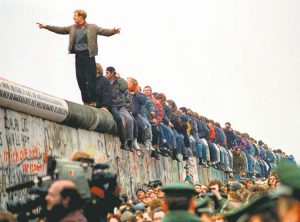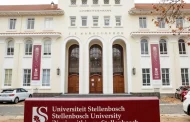In length and width, it was not the toughest wall in history but it was the most symbolic wall as long as it existed. It was the most geopolitically significant wall which was not just dividing what was East and West Germany but Communism and Capitalism. So, its fall was history unfolding in its sneaky manner. But, 30 years after, what did the fall of the Berlin Wall really mean for the world?

Typical celebratory headlines then but what now after 30 years?

And still back then
That is the question Historians are cracking their brain on this week when, in three days’s time, it would be 30 years gone by. Taken beyond Germany, it is the question of the age. That makes this a great but saddening article. Great because of the powerful mockery of the ‘false turn’ in celebrating the collapse of Socialism but saddening that the world is hostage to an inconsiderate social order as contemporary capitalism. Things are so bad that even a Prof Neil Ferguson, the Stanford Historian who once celebrated Empire, is now complaining and publishing his reservations. How bad can it go? Intervention almost re-titled this piece, “Ok, Socialism is Dead But What Has Capitalism Brought?” It didn’t because the original title is so evocative of the paradox.
According to Frieze, the art magazine from where this piece has been reproduced, Sarah James, the author, is an art historian and writer based in Frankfurt am Main, Germany. Her next book Paper Revolutions: An Invisible Avant-Garde, is forthcoming from MIT Press
The pictures used here are different from the ones in the original piece
A survey of Germany’s reunification anniversary events, from David Hasselhoff to Hito Steyerl
On a cold New Year’s Eve in 1989, David Hasselhoff – then a major TV star and soft rock hero in Germany – stood atop a twenty-metre bucket crane that swung above the remainders of the Berlin Wall. His custom leather jacket pulsated with flashing disco lights as he part-sang, part-mimed his number one hit I’ve been Looking for Freedom (1989) to camera. The Brandenburg Gate behind it, Hasselhoff’s platform veered across symbolically to each side of the former wall, fireworks exploding and fizzing all around whilst crowds gathered and cheered in a new year and a new era. Broadcast live by then West German public station ZDF TV, the celebration was attended by 500,000, and reached millions of viewers.
The Berlin-based artist Hito Steyerl has highlighted the year 1990 as a pop cultural moment replete with kitsch odes to freedom celebrating the victory of democracy with the fall of the Wall. Steyerl, who will open a solo exhibition at the city’s n.b.k this month, has described Hasselhoff’s song – which tells the story of a rich man’s son struggling to find his own way in life – as the ‘most abysmal of all these sing-along songs’. Steyerl mobilizes George Michael’s Freedom! ’90 (1990) as a counterexample, extrapolating from it a model of ‘negative freedom’.
Steyerl’s ‘negative freedom’ is a far more critical and contemporary state of freedom for our current times. This encompasses the freedom of corporations from any form of regulation or the freedom of individuals to relentlessly pursue their own interests at the expense of everybody else’s: ‘a freedom from solidarity, freedom from certainty…freedom from employment or labour, freedom from culture, public transport, education, or anything public at all, as Steyerl put it in a 2013 essay for e-flux.

Flashback to November 9th, 1989
Yet despite being abysmal, Hasselhoff’s Berlin Wall song wasn’t exactly the victorious ode to capitalism, liberal choice and entrepreneurialism suggested by staging, title and Steyerl’s dismissal. A cover of a 1978 hit composed by the German music producer Jack White, co-written by the Brit Gary Cowtan and originally sung by Marc Seaberg, its choice for the celebratory event seems either somewhat miscalculated or strangely prescient today. ‘I’ve been looking for freedom, since I left my home town, I’ve been looking for freedom, still it can’t be found…. I’ve had everything that money can buy, but freedom, I’ve had none… I’ve been looking for freedom, still the search goes on….’ the song’s protagonist declares.
The inanely upbeat verses repeatedly climax with the jarringly negative and realist sentiment that freedom – here the freedom imagined from the East as epitomised by the capitalist democratic West – is revealed as an unobtainable and unfulfilled fantasy. It couldn’t have been produced as a better parody of both capitalism and individualism’s hopeless and false quest for contentment if it had been the brainchild of East German propagandists.
This week, Germany is approaching the 30th anniversary of the fall of the Wall, marked by a vast number of artistic and cultural events – many of which grapple with its ambivalence and the still ongoing fall-out: both in terms of the resurgence of the far right across Germany, as well as the loss of an alternative model – however flawed – to neo-liberalism that the dissolution of the GDR and the other socialist states represented across the East. Berlin has an entire festival programme dedicated to this anniversary, including a special presentation titled ‘Comrade we must know Everything!’ about Stasi surveillance at the Stasi Museum and former headquarters in Lichtenberg on 8 November. An event at the Berlin Wall Foundation on 9 November explores the specific impact on Germany’s Turkish community. This panel will examine the immediate rise of xenophobia across Germany but particularly in the former East, including many racist pogroms and attacks in the 1990s – such as the arson attack of 1993 that killed 5 Turkish children and young women in the German city of Solingen.
Perhaps due to the direct connection between the fall of the Wall and current political debates over German identity, many of these cultural events and art exhibitions tread carefully, engaging with specific geographies and locations in Berlin that marked the border between East and West from a comparative perspective as well as embracing a kind of Alltagsgeschichte (‘everyday history’, a micro-historical perspective popularized in Germany in the 1980s that reclaims oral histories and anthropologies of normal and working-class people). ‘But it is nice that the Wall has got holes’, a show currently on display in the forecourt of the Berlin House of Representatives, displays photographs of the Wall alongside excerpts from private correspondence between people living in the two Germanies.

Another iconic picture from yesterday
The group show and project ‘1989-2019: Politics of Space in New Berlin’ recently at n.b.k. engaged with the well-known and ongoing debates about the city’s ruthless gentrification and neo-liberalization via a focus on urban planning and political policy in the wake of the dissolution of the ideological binaries of the cold war. The show locates ‘creative Berlin’ from a post-financial crisis perspective as a place of many mythological constructions: for example, Andrej Holm’s Glossary of Privatization visualises the scale of the sale of previously state-owned real estate in the city since 1990.
Steyerl’s show will comprise a live-stream lecture and site-specific installation alongside her video This is the Future (2019): a dystopian post-human reflection via artificial intelligence on planetary crisis and technology, which along with distorted images of Venice (it was shown at the last biennale), psychedelic flowers and tropical fish includes a few seconds of footage from a recent German far-right protest.
Other Berlin exhibitions view the fall of the Wall via the present political crisis in Germany – one defined by ‘extreme nationalism and polarising populism’ – as Sam Bardaouil and Till Fellrath, the curators of Gropius Bau’s ‘Walking Through Walls’ group show put it in the blurb. For them, the fall of the Wall was ‘one of the most symbolic events of the 20th century’ but now provides the all-pervasive condition of our time: one of vulnerability and anxiety produced by ‘power structures that thrive on confinement and segregation.’ Alongside works dealing with segregation and immigration by Mona Hatoum and Gustav Metzger, the Danish artist Michael Kvium’s huge painting Beach of Plenty (2017) depicts the unnerving meeting of Mediterranean holidaymakers with refugees fleeing war and starvation in a rubber dinghy.
Unsurprisingly, the commemorative perspective outside of Berlin is far less Wall-centric. In Dresden, the art world has had to respond to a situation where the city and its cultural institutions are under siege by PEGIDA. The far right make clear they are fighting a cultural war, and the AfD puts continual and strategic pressure on art institutions it views as left-wing – the politics of commemoration, reunification and German identity are especially fraught. For example, in Dresden the AfD were central in organising protests against a public art installation ‘Monument’ (2017) by the Syrian German artist Manaf Halbouni. Comprising a barricade of wrecked buses it was meant to replicate the ones erected in war-torn and Aleppo by the people to protect them from regime snipers – the artist explaining it was intended as a symbol of peace and freedom. Crowds of PEGIDA members protested its unveiling and AfD’s politicians Carsten Hütter branded it a monument to the Sharia state. The AfD have also made clear that they intend to use their parliamentary power to attack all arts and culture programs and institutions that deal with multicultural and Islamic subjects or involve artists and individuals with Islamic or Muslim ethnicities.

Back then as captured by this British newspaper
There are few artistic or institutional attempts to commemorate the fall of the Wall in Dresden. Instead, the city’s Kupferstich-Kabinett is hosting a major retrospective of the Dresden-born photographer Christian Borchert, who died in Berlin in 2000. Titled ‘The Techtonics of Remembrance’, it offers a nuanced and critical depiction of life in the former East Germany – including his family portraits of the 1980s and early 1990s, which make striking contemporary contrast to the Becher School images of Thomas Struth. The museum has also chosen to focus more on the 30th anniversary of the reunification of Germany – with a month-long exhibition of the East German photographer Andreas Rost’s Reunification (2019) planned to open in October 2020.
Hasselhoff’s peculiar televised performance – perhaps the first mass public commemoration of the fall of the Wall – with all its kitsch euphoria and paradoxes, attested to the complexities involved in celebrating and marking an event that would change the lives, futures and everyday realities of so many. When Hasselhoff performed his paradoxical disco requiem, he was singing into a temporary historical no man’s land – the reunification of Germany was not officially ratified until 2 October 1990. Despite what the event was intended to be, the New Year’s Eve 1989 celebrations and Hasselhoff’s performance represented more of a fleeting, shifting, momentary model of solidarity and a grappling with different public spaces and publics than simply a celebration of the liberal West’s victory.
From the present no man’s land of endless Brexit negotiations, spiralling refugee crises and the rise of far-right nationalisms, Hasselhoff’s song for freedom seems both more absurd, but also in some ways still more radical and more graspable than Steyerl’s post-human dreamscape and its negative freedoms. The more productive events and exhibitions turning to the fall of the Wall, German reunification and its aftermath in Berlin and beyond have not only looked into the future and critiqued the present, but have attempted to re-engage in historical and progressive models of community, solidarity, belonging and experience that might, if we are very lucky, be retooled and mobilised in the present.




























